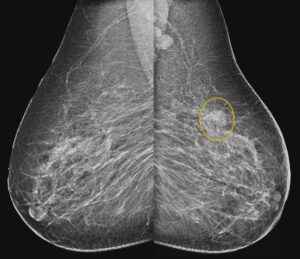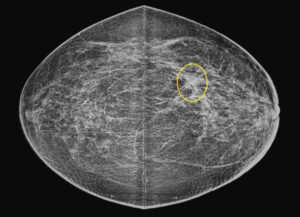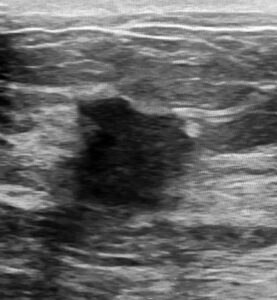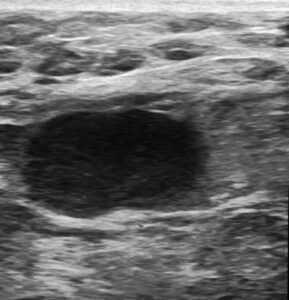
Targeted ultrasound for the diagnosis of mammographic masses with obscured borders
- Posted by Mirror Organization
- Categories Cases
- Date September 22, 2023
- Comments 0 comment
Author / Copyright: Dr. Dina Elmetwally (Mansoura University)
Clinical History
A 51 years old female patient presented by palpable left breast mass.
Case Imaging Scenario
- The patient was referred for mammography as the primary imaging modality.
- Mammography showed an irregular shaped mass with obscured borders in the upper outer quadrant of the left breast.
- By complementary ultrasound we found an irregular shape hypoechoic mass with spiculated borders and posterior shadowing in the upper outer quadrant of the left breast.
- On examining the left axilla, we found multiple enlarged left axillary lymph nodes showing distorted shape and lost hilum.
- The patient was categorized as BI-RADS 5 and biopsy revealed left breast grade II invasive duct carcinoma.
Case Description /Discussion
Diagnostic mammography is indicated for women more than or equal to 40 years presenting with a palpable mass. In several series evaluating palpable breast abnormalities (1-3), the sensitivity of mammography alone was 86% to 91%. If a clearly benign correlate for a palpable finding (oil cyst, hamartoma, degenerating fibroadenoma, lipoma, benign lymph node) can be identified on mammography, this modality alone may be sufficient and clinical follow-up rather than imaging follow-up or tissue sampling is appropriate. If the mammogram is negative or an imaging correlate is identified that is not clearly benign, multimodality imaging is usually indicated in this age group, with targeted US directed toward a palpable finding (4).
In the presented case, the patient had a palpable mass, the nature of the mass could not be clearly defined on basis of mammography due to the overlapping glandular tissue, therefore US was necessary to identify the nature of the mass which revealed typically malignant mass with malignant axillary LNs.
Teaching Points:
In patients more than 40 years, mammography may be sufficient if there is a clearly seen benign-looking correlate on the mammogram for the palpable finding. Otherwise, other imaging modalities for example targeted US is mandatory for diagnosis.
Final Diagnosis:
Grade II invasive duct carcinoma.
Keywords:
Obscured borders, mammography, ultrasound, malignant, axillary nodes, invasive duct carcinoma.
References;
- Ciatto S, Houssami N. Breast imaging and needle biopsy in women with clinically evident breast cancer: does combined imaging change overall diagnostic sensitivity? Breast. 2007;16(4):382-386.
- Murphy IG, Dillon MF, Doherty AO, et al. Analysis of patients with false negative mammography and symptomatic breast carcinoma. J Surg Oncol. 2007;96(6):457-463.
- Shetty MK, Shah YP, Sharman RS. Prospective evaluation of the value of combined mammographic and sonographic assessment in patients with palpable abnormalities of the breast. J Ultrasound Med. 2003;22(3):263-268; quiz 269-270.
- American College of Radiology ACR Appropriateness Criteria® Palpable Breast Masses. 2016.
Origin of Figures:
The imaging investigations were obtained by using the following methods: Mammogram: Genoray MX 300 and Ultrasound machine: Logic p5.

Figure 1: A (mediolateral oblique) and B (craniocaudal) mammographic images showed irregular shaped mass with obscured margins in the upper outer quadrant of the left breast associated with enlarged ipsilateral axillary nodes (noted at the medio lateral oblique view). Concomitant left breast diffuse skin and trabecular thickening.

Figure 1: A (mediolateral oblique) and B (craniocaudal) mammographic images showed irregular shaped mass with obscured margins in the upper outer quadrant of the left breast associated with enlarged ipsilateral axillary nodes (noted at the medio lateral oblique view). Concomitant left breast diffuse skin and trabecular thickening.

Figure 2: Ultrasound image showed an irregular shaped hypoechoic mass with spiculated borders and posterior shadowing in the upper outer quadrant of the left breast.

